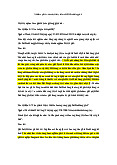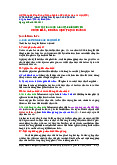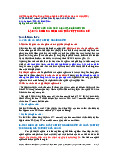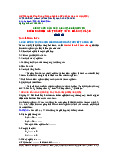



















Preview text:
MINISTRY OF EDUCATION & TRAINING HOA SEN UNIVERSITY
FACULTY OF MARKETING – COMMUNICATION FINAL REPORT Subject: Product Management Instructor: Phan Minh Tuấn Class: 2334 Group 4 Members: Students Student IDs Lã Nguyễn Triều Tân 22102423 Mai Đào Tuyết Trâm 22104397 Phạm Ngọc Thiên Trang 22117394 Nguyễn Bảo Toàn 22106381 Nguyễn Thanh Hoàng 2199004 Trần Trúc Hiếu Quỳnh 22006512 Phạm Hà Thảo Dung 22108675 August 2024 i
MINISTRY OF EDUCATION & TRAINING HOA SEN UNIVERSITY
FACULTY OF MARKETING – COMMUNICATION FINAL REPORT Subject: Product Management Instructor: Phan Minh Tuấn Class: 2334 Group 4 Members: Students Student IDs Lã Nguyễn Triều Tân 22102423 Mai Đào Tuyết Trâm 22104397 Phạm Ngọc Thiên Trang 22117394 Nguyễn Bảo Toàn 22106381 Nguyễn Thanh Hoàng 2199004 Trần Trúc Hiếu Quỳnh 22006512 Phạm Hà Thảo Dung 22108675 August 2024 ii WORK ASSIGNMENT TABLE Students Student IDs Percentage Lã Nguyễn Triều Tân 22102423 100% Mai Đào Tuyết Trâm 22104397 100% Phạm Ngọc Thiên Trang 22117394 100% Nguyễn Bảo Toàn 22106381 100% Nguyễn Thanh Hoàng 2199004 100% Trần Trúc Hiếu Quỳnh 22006512 100% Phạm Hà Thảo Dung 22108675 100% iii TABLE OF CONTENT
WORK ASSIGNMENT TABLE ....................................................................................... iii
TABLE OF CONTENT ..................................................................................................... iv
LIST OF PICTURES ....................................................................................................... vii
LIST OF TABLES ........................................................................................................... viii
PART 1: NEW PRODUCT CREATION ........................................................................... 9
I. Idea Generation .......................................................................................................... 9
II. Evaluating The Idea ............................................................................................... 11
1. Idea Formation Process ....................................................................................... 11
2. Choosing and Ranking Factors .......................................................................... 13
3. Type of New Product ........................................................................................... 15
PART 2: PRODUCT INNOVATION CHAPTER .......................................................... 16
I. Background ............................................................................................................... 16
II. Focus ........................................................................................................................ 16
III. Goals and Objectives ............................................................................................ 17
IV. Guidelines ............................................................................................................... 17
PART 3: NEW PRODUCT PROCESS ............................................................................ 19
I. PHASE 1: Opportunity Identification And Selection ........................................... 19
1. Situations .............................................................................................................. 19
2. Trends ................................................................................................................... 19
3. The Change in Shopping Generations ............................................................... 20
II. PHASE 2: Concept Generation ............................................................................. 20
1. Concepts Information Process ............................................................................ 20
2. Market Research .................................................................................................. 24 iv
3. Perceptual Map .................................................................................................... 26
4. Judgment .............................................................................................................. 29
III. PHASE 3: Concept Evaluation ............................................................................ 29
1. A-T-A-R Model .................................................................................................... 29
2. Total Cost to Produce A Unit .............................................................................. 31
3. NPV ....................................................................................................................... 33
4. House of Quality ................................................................................................... 35
IV. PHASE 4: Development ........................................................................................ 36
1. Benefit ................................................................................................................... 36
2. Chunks and Functions ......................................................................................... 36
3. The Detail of The Product ................................................................................... 38
4. Components .......................................................................................................... 41
5. Packaging .............................................................................................................. 43
6. Logo ....................................................................................................................... 44
V. PHASE 5: Launching The Product ....................................................................... 44
1. Situation Analysis ................................................................................................ 44
1.1. Industry Background .............................................................................................................. 44
1.2. Company Background ............................................................................................................ 45
1.3. SWOT Analysis ........................................................................................................................... 45
2. Marketing Objectives .......................................................................................... 47
3. Marketing Strategy .............................................................................................. 49
3.1. General Marketing Strategy .............................................................................................. .49
3.1.1. Segmentation And Targeting .................................................................... 49
3.1.2. Brand Differentiation Strategy ................................................................. 51
3.1.3.Brand Positioning Strategy ....................................................................... 51
3.2. Specific Target Market Strategies .................................................................................. .51
3.2.1. The Product Strategy ................................................................................ 51
3.2.2. The Pricing Strategy ................................................................................. 52 v
3.2.3. Distribution Strategy ................................................................................ 53
3.2.4. Communication Strategies ........................................................................ 53
4. Action Program .................................................................................................... 54
4.1. Communication Plan (IMC Plan) .................................................................................... 54
4.1.1. Media Objectives ...................................................................................... 54
4.1.2. Media Tools .............................................................................................. 54
4.1.3. Media Plan ............................................................................................... 55
4.2. Timeline ........................................................................................................................................... 63
4.3. KPIs ................................................................................................................................................... 63
4.4. Marketing Budget ...................................................................................................................... 64
PART 4: INTELLECTUAL PROPERTY REGISTRATION (CHAPTER 6) ................ 69
REFERENCES ................................................................................................................ 70 vi LIST OF PICTURES
Picture 1: Type of New Product ........................................................................................ 15
Picture 2: Perceptual .......................................................................................................... 28
Picture 3: House of quality ................................................................................................ 35
Picture 4: Packaging of Smart Working Chair .................................................................. 43
Picture 5: Brand's logo of smart working chair ................................................................. 44
Picture 6: Timeline Media Plan ......................................................................................... 63 vii LIST OF TABLES
Table 1: VRIN Model ....................................................................................................... 12
Table 2: Ranking Factors .................................................................................................. 14
Table 3: Concept Generation Process ............................................................................... 21
Table 4: Market Research Result ...................................................................................... 25
Table 5: Comparison of four key features between our product and those of other
companies. ......................................................................................................................... 26
Table 6: Comparison of our products against competitors ............................................... 27
Table 7: Result of the survey ............................................................................................. 30
Table 8: Physical Value Product ....................................................................................... 32
Table 9: Data for NPV of Concept 2 (Million VND) ....................................................... 33
Table 10: Data for NPV of Concept 3 (Million VND) ..................................................... 34
Table 11: Chunks and functions of Smart Working Chair ................................................ 37
Table 12: Details of Smart Working Chair ....................................................................... 39
Table 13: Components of Smart Working Chair .............................................................. 41
Table 14: SWOT analysis of the product ......................................................................... 46
Table 15: Media Tools used in the IMC plan .................................................................... 54
Table 16: Media Plan for Stage 1 ...................................................................................... 56
Table 17: Media Plan for Stage 2 ...................................................................................... 58
Table 18: Media Plan for Stage 3 ...................................................................................... 60
Table 19: Media Plan for Stage 4 ...................................................................................... 62
Table 20: Budget ............................................................................................................... 64 viii
PART 1: NEW PRODUCT CREATION I. Idea Generation
Idea 1: New terminator type
Product: The product is combined with two types of soy sauce: black soy sauce and red
soy sauce, creating a rich, characteristic flavor for users. Customers can use this type of
soy sauce to eat with pho, fried fish balls, or other dishes to have a real culinary experience
without having to use a lot of spices.
Context: For Pho lovers, the dipping sauce not only enhances the flavor of Pho but also
adds saltiness, sweetness and spiciness, creating a harmonious balance for the dish. In
addition, the bottles we use can be reused to suit the purpose of environmental protection
Payment: Pay cash after receiving products at the store
Distribution: At grocery stores, convenience stores or supermarkets
Idea 2: Fermented cheese from soy milk
Product: Applying research results in 2007 and commercializing them for vegans. Soy
milk is fermented with lactic acid bacteria or yeast to produce flavor compounds similar to the font system.
Context: Fermented soy cheese, also known as vegan cheese, is an alternative to traditional
cheese made from animal milk, for those who are vegetarian, vegan or allergic to milk.
Distribution: In vegan product stores and supermarkets 9
Idea 3: Smart working chair
Product: The massage ergonomic chair combines the features of an office chair with a
massage function to improve comfort and reduce stress while working.
Context: Genuine cowhide working chair with soft and smooth lining, integrated multi-
mode massage function, with many massage points such as neck, shoulders, nape, back,
legs, etc. Combined with a smart control panel On the armrest, you can adjust the massage
mode, height, or backrest of the chair.
Target customer: For people who sit for long hours or office workers.
Expiry date: 1 year
Payment: Pay cash after receiving products at the store, transfer.
Distribution: E-commerce platforms, electronics supermarkets.
Idea 4: Hybrid motorbikes
Product: This is a vehicle that is a harmonious combination of a traditional gasoline engine
and an electric motor. This combination not only provides strong performance but also
helps save significant fuel and reduce emissions, contributing to environmental protection,
optimizing technology as well as improving savings.
Context: Hybrid motorcycles offer many benefits in different usage contexts, from urban
environments to rural and commercial applications. The combination of a gasoline engine
and electric motor improves fuel efficiency, reduces emissions, and provides flexible
operation in a variety of conditions.
Distribution: Good car market, car companies 10
Idea 5: Watch washing machine
Product: Applying handpiece washing technology in dentistry to produce watch washing
machines for the need to protect and care for watches at home.
Context: Watch washers play an important role in maintaining and cleaning watches,
especially high-end and complicated watch models. The development of technology such
as ultrasound and steam has provided many effective options for cleaning. These machines
not only help maintain the performance and value of the watch, but also save time and
maintenance costs. When choosing a watch washer, understanding the needs and features
of the product will help you make the most accurate and appropriate decision.
Distribution: Watch Shops and Service Centers, Electronics and Industrial Tools Stores, Online Stores. II. Evaluating The Idea 1. Idea Formation Process
To help screen and select good ideas, step 1 we use VRIN model. VRIN stands for Valuable,
Rare, Inimitable and Non–substitutable. •
Valuable: Value chain analysis helps identify value-generating activities in the
production and supply process. Valuable products such as improving production
processes and improving customer service quality •
Rare: Analyze the market and competitors. Companies can adopt strategies such as
protecting intellectual property rights (patents, trademarks), creating proprietary
products or services, and building customer or partner relationships. special work. 11 •
Inimitable: Barriers to entry can be built for competitors by investing in research
and development and building strategic relationships with key partners. Make it
impossible for competitors to easily imitate the product •
Non - substitutable: Companies can focus on developing unique products or
services where no competitors can create similar products at the same level of value.
This may include maintaining continuous innovation and improving quality. Table 1: VRIN Model Non - Idea Valuable Rare
Inimitability substitutable New terminator type x x _ _ Fermented cheese x x from soy milk _ x Smart working chair x x x _ Hybrid motorbikes x _ x _ Watch washing x x x machine _
After analyzing VRIN model “Fermented cheese from soy milk”, “Smart working
chair” and “Watch washing machine” are the most potential ideas that will gain strong
competitive advantages and high margins for the company. 12
2. Choosing and Ranking Factors Meet demand (25%)
The principle to make a product / service is first to meet the needs, market trends,
and predictive analytics to forecast future demand. In other words, create products that
customers need, not products that the business already has. This will make the product
valuable to customers and bring profits to the business, so this is one of the indispensable
factors when evaluating the product. However, the 3 products/services that the group chose
are all in the niche market, so customer demand will not be high until the product/service
is launched on the market. Therefore, customer demand will not account for a high
proportion compared to other products/services. Therefore, its weight will be 25%. Difference (20%)
The products or services that businesses provide must have differences in quality
and features. That will make a difference and stand out from other products on the market.
In addition, it is also a premise to convince customers to choose to use the business's
products/services over other competitors. Differences can sometimes create customer
needs for its novelty and goodness. So the “Difference” would be 20%. Price (15%)
Price is the amount a consumer must pay to purchase a product or service. This is
an important factor in commercial activities and has a great influence on customers'
purchasing decisions. Since then, the "Price" factor will have a weight of 15%. Convenience (10%)
Convenience includes such factors as: Ease of use, simple and easy to use service.
This will make customers feel no trouble when using products and services and will
continue to use for a long time. So, this accounts for 10%. 13 Satisfied (20%)
Satisfaction will bring trust, loyalty to customers . When they are happy about the
product or service they will recommend, speak well about what they are using for others.
This will help businesses have a foothold in the market and expand. We put 20% for its weight.
Table 2: Ranking Factors Concept 2 Concept 3 Concept 5 Items Radio Rank Mark Rank Mark Rank Mark Meet demand 25 3 75 4 100 3 75 Differences 20 3 60 5 100 4 80 Price 20 3 60 4 80 4 80 Convenience 15 4 60 4 60 5 75 Satisfied 20 5 100 5 100 4 80 Total 100 355 440 390
After considering and evaluating the top two potential ideas on a scale of 5, we
decided that the idea "Smart Working Chair" will be produced and developed for the
market because it received a better score than the two other ideas (440 vs. 390 and 355). 14 3. Type of New Product
Picture 1: Type of New Product 15
PART 2: PRODUCT INNOVATION CHAPTER I. Background
In today’s fast-paced technological world, people are spending more and more time
sitting. This sedentary lifestyle has led to an increase in health issues such as back pain,
poor posture and obesity. Recognizing this growing concern, we present an innovative
smart office chair designed with user health and productivity in mind. Combining advanced
technology with ergonomic design, our chairs provide a superior sitting experience,
promoting a healthier and more comfortable work environment. II. Focus
This is a premium office chair that integrates smart features to optimize the user's
comfort, support, and overall health. Our chair offers a personalized sitting experience
through customizable massage settings, adjustable seat cooling, and real-time health
monitoring. Leveraging advanced sensors and AI technology, the chair tracks sitting
posture, sitting time, and other relevant data to provide insights and action reminders to maintain good health habits.
Target market and target customer: •
Target market includes people living and working in Ho Chi Minh City area. •
Target customers include people from 35 - 60 years old, tech-savvy people who
value health and prioritize ergonomic chair design with advanced features in their workspace. POD: •
Advanced health tracking and personalized recommendations • Customizable massage 16 •
Premium materials and ergonomic design • Sleek and modern design
III. Goals and Objectives
The main goal is to build a smart office chair that is one of the leading smart office
chairs on the market, redefining the standard of comfort and health care in the workplace
and increasing brand awareness by 30% through marketing activities and reaching more
than 2,000,000 people across all advertising channels. In addition, the product must achieve
at least 50,000 interactions (likes, shares, comments, clicks) on social media and advertising platforms.
We aim to achieve this goal by building a strong brand and focusing on improving
a regular office chair into a smart chair that is comfortable to sit on and can monitor health
but is no less luxurious. In addition, we need to build a loyal customer base through
excellent product performance and customer support and achieve a customer satisfaction
rating of 4 out of 5. In addition, expanding our product line is also important to meet the
needs of today's people. Finally, we need to build strategic partnerships with healthcare
providers and ergonomic experts to bring the best features and performance to consumers. IV. Guidelines
Innovation: Smart Work Chairs represent a significant step forward in office chair
technology. By integrating advanced features such as massage, AI-based health monitoring
and personalized comfort settings, we are setting a new standard for the industry.
Design and functionality: The design of the chair must harmoniously combine
aesthetics and ergonomic comfort. The use of high-quality materials and advanced
manufacturing techniques will ensure durability and comfort. The user interface must be intuitive and easy to use. 17 Timing
This is a new product line and is applied with many advanced technologies that are
completely different from the usual office chair. With the increasing awareness and
demand for health and comfort at work of people today, the market is ready for a product
like ours. We plan to launch the Smart Work Chair product in September 2024 to capitalize
on the growing demand for smart and healthy living solutions. Copyright protection
We will protect our intellectual property through patents, trademarks and copyrights.
This will protect our unique innovations and prevent unauthorized copying. 18
PART 3: NEW PRODUCT PROCESS
I. PHASE 1: Opportunity Identification And Selection 1. Situations
The post-pandemic era has seen a significant increase in remote work and hybrid
office setups. As employees work from home more frequently, there is a rising demand for
home office equipment that combines comfort, functionality, and luxury. This shift has led
to a surge in the market for office chairs, desks, and accessories that not only provide
physical support but also enhance the overall aesthetic of home offices. Companies are
responding by offering innovative products designed to meet the evolving needs of remote
workers, emphasizing health benefits and style. 2. Trends
The wellness industry, valued at $4.5 trillion in 2018 by the Global Wellness
Institute, continues to grow as consumers become increasingly aware of the health risks
associated with prolonged sitting, such as back pain, poor posture, and circulation problems.
Ergonomic office chairs that offer therapeutic benefits are becoming popular, designed to
support the body's natural alignment, reduce strain, and improve overall comfort. The
adoption of smart home technologies is extending to office furniture, with consumers
seeking products that offer ease of use, connectivity, and customization through smart
technology. Integration with smart home ecosystems and mobile apps allows users to
control and personalize their furniture settings seamlessly, enhancing comfort and
convenience. Office workers require chairs with adequate lumbar support, adjustability,
and overall comfort to reduce the strain of long sitting hours. Chairs with massage functions
making the office chairs that also serve as personal masseuses attractive investments due
to their dual benefits. Combining ergonomic support with massage features enhances both
comfort and productivity, catering to those who seek efficient and relaxing workspaces. 19
3. The Change in Shopping Generations
Younger generations, such as Millennials and Gen Z, are driving the demand for
smart and multifunctional furniture, prioritizing health, wellness, and technology
integration in their purchasing decisions. This demographic is more likely to invest in high-
tech, ergonomic office furniture that enhances their work-from-home experience. A report
by Statista shows that the global smart home market is projected to reach $151.38 billion
by 2024, reflecting their preference for connectivity and ease of use. They also tend to
value experiences over ownership, preferring furniture that offers multifunctional benefits,
such as ergonomic support combined with massage features, enhancing their overall
lifestyle and well-being. The multifunctional furniture market is projected to grow from
$8.52 billion in 2020 to $13.34 billion by 2027, at a CAGR of 6.6%, according to Allied
Market Research. Generations Y and Z have high expectations for both design and
functionality, seeking products that not only look good but also provide tangible health and
productivity benefits. The global ergonomic chair market is expected to grow from $9.2
billion in 2020 to $14.9 billion by 2026, at a CAGR of 7.4%, according to a report by
MarketsandMarkets. The emphasis is on creating a stylish, comfortable, and efficient home
office environment that reflects their personal taste and professional needs.
II. PHASE 2: Concept Generation
1. Concepts Information Process 20




